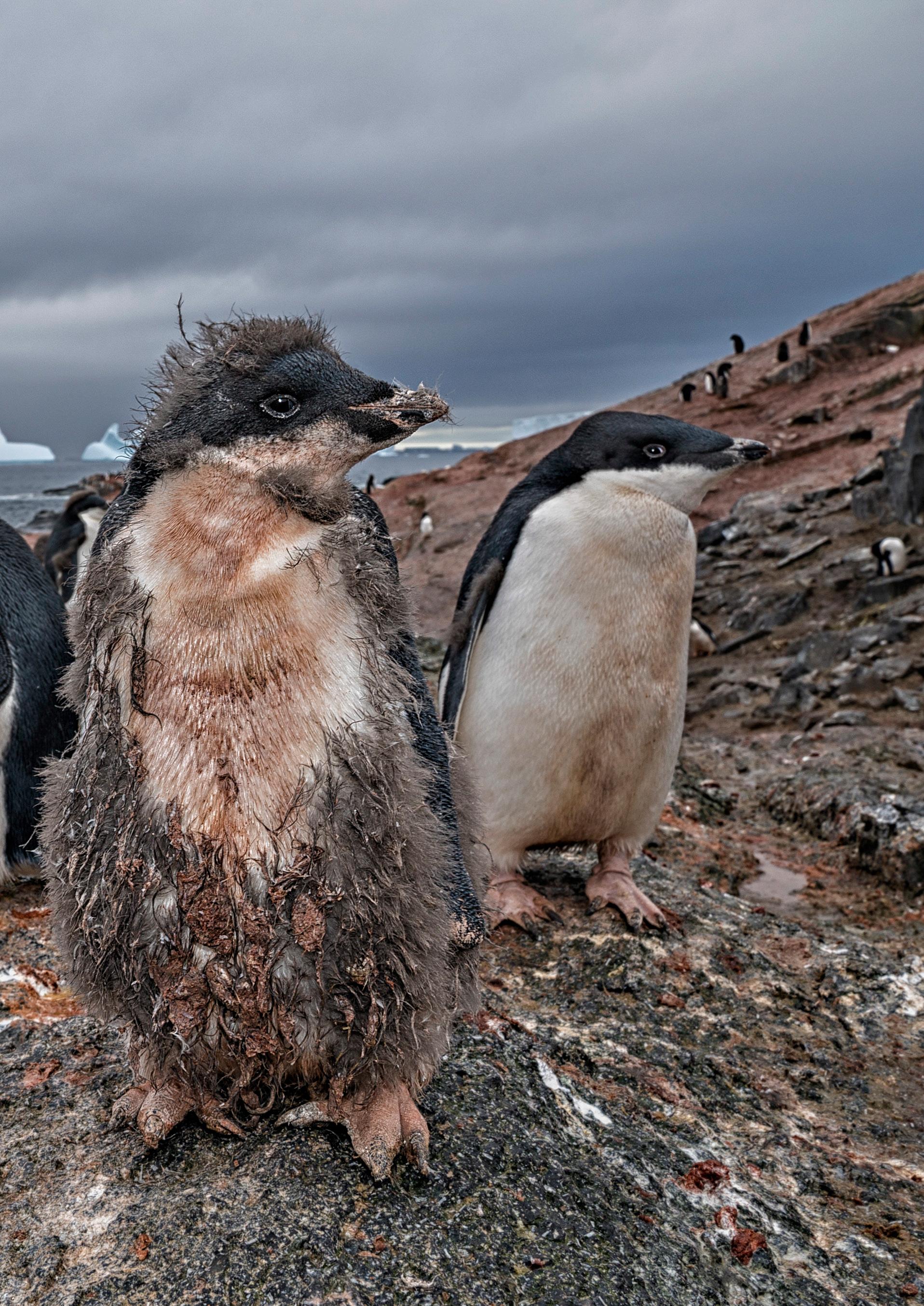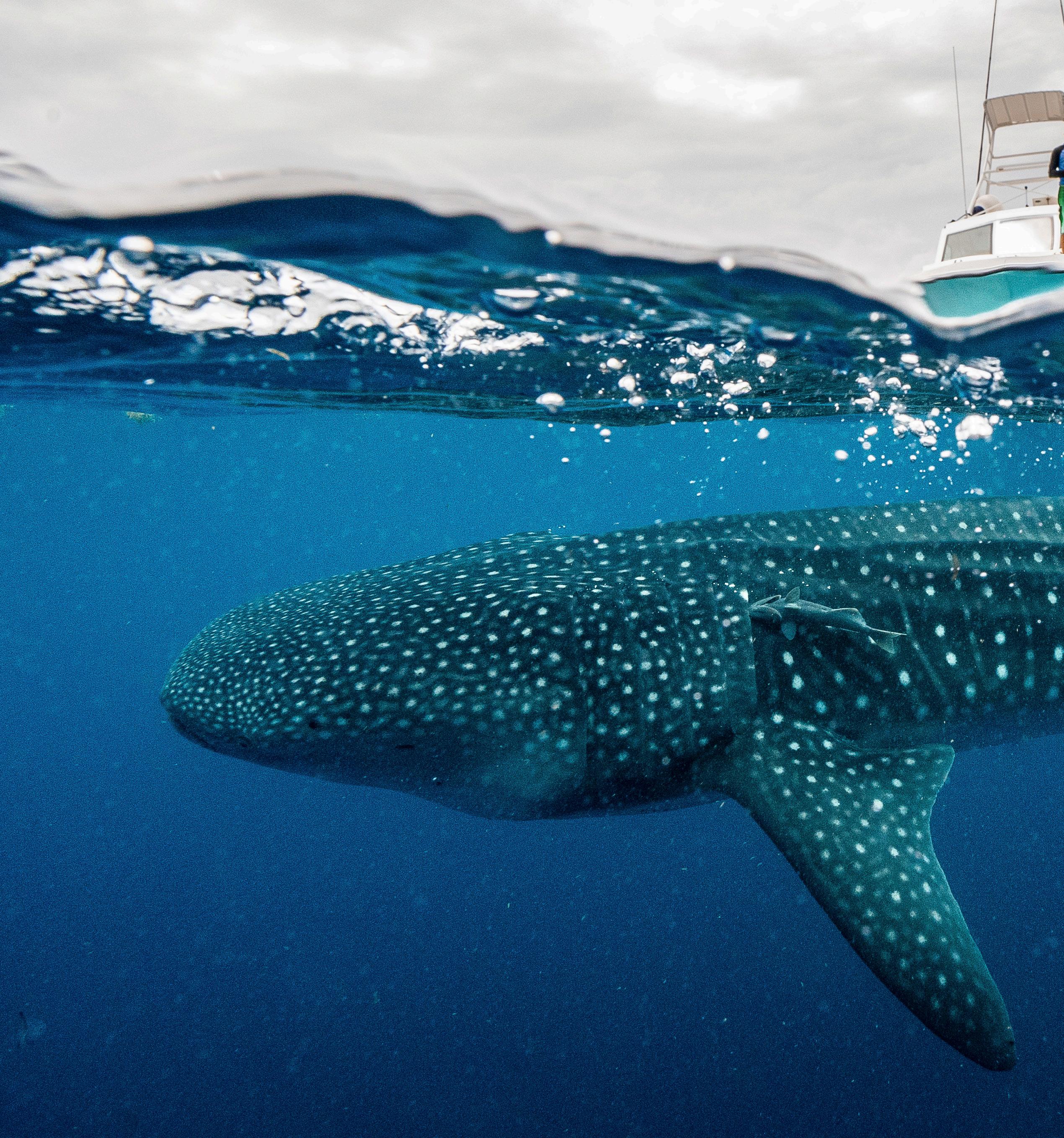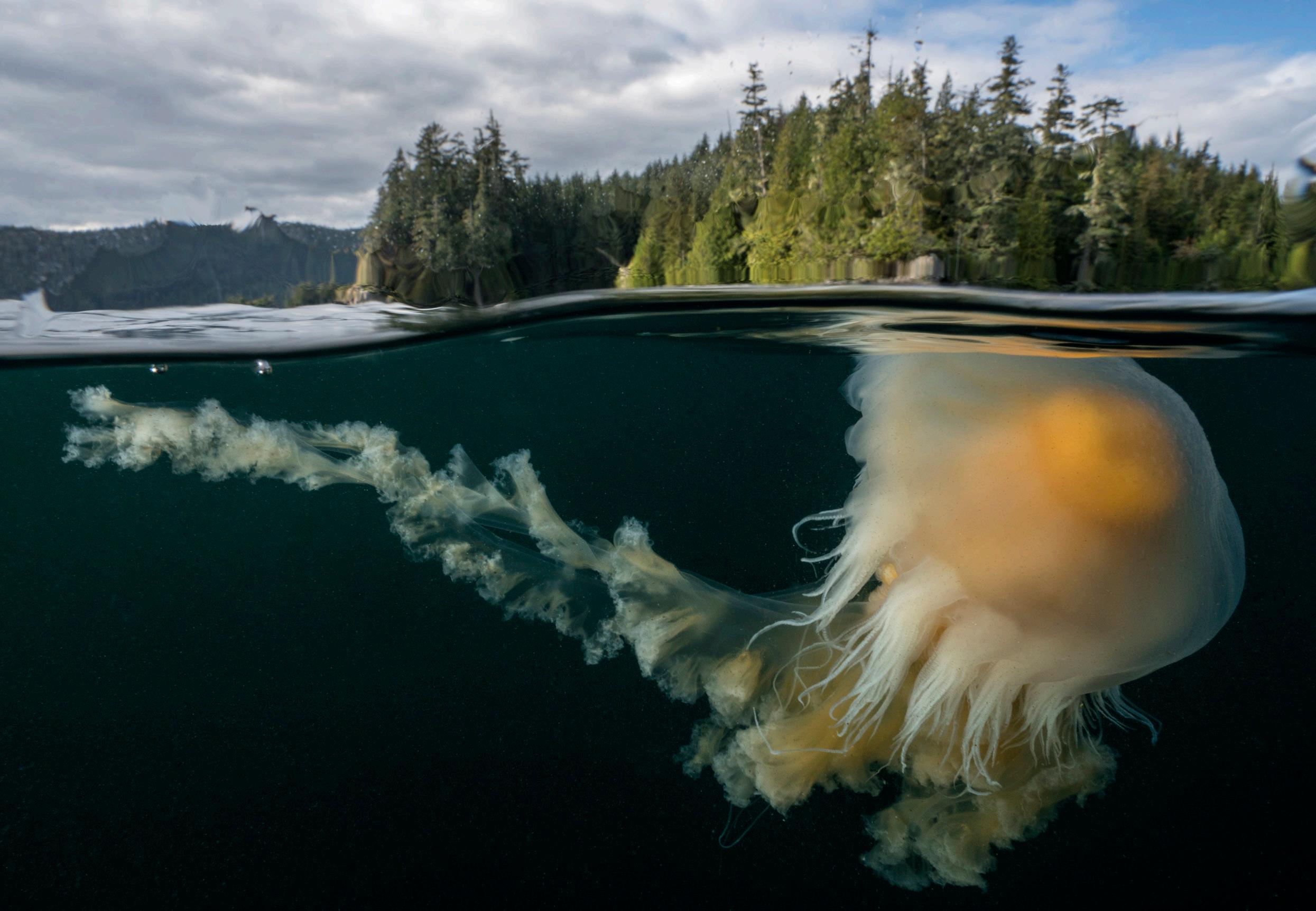
9 minute read
A Life's Mission
FEATURE TONY SIDGWICK & ALLY LANDES PHOTOGRAPHY CRISTINA MITTERMEIER

Small, fuzzy, and fearless, a penguin chick stands its ground in the safety of its crèche; the term for a small group of baby penguins. But in a drastically shifting climate, these little birds are far from safe. The Antarctic peninsula is facing warmer weather with an increase in rainfall instead of snow flurries. This small change in the environment seems like it wouldn’t have much of an impact, but its effects are disastrous. To learn more, visit: www.SeaLegacy.org.
Cristina Mittermeier

ISLA MUJERES, 2019 | Eco-tourism initiatives have changed the ways that people make their livelihoods around the world; transforming shark fishermen into ocean guardians and tour guides in Isla Mujeres, and boosting economies on a global scale as adventurers travel far and wide in the name of discovery and new experiences. However, as it gets easier to travel the world and eco-tourism becomes more accessible, it is important and necessary to implement regulations and best practices for the health and safety of animals, ecosystems, and humans. When you’re an eco-tourist, think of yourself as a guest in someone’s home. Because that’s what you are.
Cristina Mittermeier
Cristina Mittermeier is a world-renowned conservationist and award-winning photographer and documentarian. A marine biologist who has been working as a writer and photographer for the past 25 years, her work has been featured in hundreds of publications, including some of the world’s most prestigious journals – TIME, National Geographic, MacLean’s and The Atlantic, to name a few.
Cristina has made it her life’s mission to highlight the spectacular beauty of the world’s natural environment, as well as the many grave challenges it faces, through her photography. Her work bridges the gap between the efforts of countless scientists and conservationists the world over, and a public largely unaware of their monumental efforts to monitor, protect and conserve the planet’s delicate and complex ecosystem.
A highly active conservationist, Cristina has participated in many international environmental programmes the world over, and co-founded several organisations of her own, including the International League of Conservation Photographers (ILCP) in 2005, the non-profit organisation SeaLegacy in 2014, and a first-of-its-kind ocean conservation action platform called Only One launched earlier this year.
THE POWER OF AN IMAGE
Cristina and her partner, renowned National Geographic photographer Paul Nicklen, captured the world’s attention in 2017 when they released images and footage of an exhausted and emaciated polar bear struggling to survive in an Arctic environment almost completely devoid of sea ice. When Paul posted the footage on social media, he added the caption, “This is what starvation looks like.”
However, when National Geographic featured the same footage, they went with the more sensationalist, “This is what climate change looks like.” This would go on to cause a storm of controversy, as many claimed that it was impossible to prove a direct link between climate change and this individual bear’s struggle to survive. Polar bears can starve due to a number of non-climaterelated reasons, including illness, injury, age and sheer bad luck.

EGG YOLK JELLYFISH Bridging the gap between above and below, this egg yolk jellyfish dances on the thin blue line; a symbol of how connected the two worlds are. (Salish Sea, British Columbia, Canada.)
Cristina Mittermeier
The Power of the imagery and footage was undeniable – it became National Geographic’s most-viewed video ever, and was picked up by news platforms across the world, reaching an estimated 2.5 billion people – but by then Cristina and Paul had lost control of the narrative.
Cristina maintains that their work was not intended to highlight the plight of this particular bear, but more to provide a stark visual warning of the potential fate that awaits ALL polar bears if their natural habitat continues to be destroyed by climate change and human activities such as pollution, resource extraction and over-fishing.
In a follow-up article a year later in National Geographic, Cristina wrote, “Perhaps we made a mistake in not telling the full story – that we were looking for a picture that foretold the future and that we didn’t know what had happened to this particular polar bear. I can’t say that this bear was starving because of climate change, but I do know that polar bears rely on a platform of sea ice from which to hunt. A fast-warming Arctic means that sea ice is disappearing for increasingly longer periods of time each year. That means many more bears will get stranded on land, where they can’t pursue the seals, walruses, and whales that are their prey and where they will slowly starve to death.”
When all was said and done, though, the most important achievement of the footage was to demonstrate the power of visual media in highlighting the plight of wildlife and broadcasting it to vast audiences across the world. As the old saying goes, “A picture paints a thousand words.” And thanks to the digital age, these days a picture can reach a billion people too.
“One of the major lessons to come from this was how much work there is still to do. The volume of climate change deniers that are out there was revealed. It was a shocking glimpse into the depth and range of denial,” says Cristina.
CRISTINA’S LIFE’S WORK
A woman with an incredible and formidable life’s mission, Cristina’s achievements over the course of a lifetime are truly an inspiration.
In 2005, she founded the International League of Conservation Photographers (ILCP) providing photographers a platform to work on environmental issues. When she began her career as a professional photographer, she discovered that many nature photographers were not interested in using their images to promote conservation, but there were a handful, however, who did.
She convened a meeting of photographers at the 8 th World Wilderness Congress in Alaska and this is where they created the ILCP organisation which allowed them to raise money for conservation projects by focusing on imagery and storytelling. Cristina was the Executive Director and the President of the ILCP until 2010.
In 2014 she co-founded SeaLegacy with her partner, Paul Nicklen. SeaLegacy is a nonprofit organisation dedicated to promoting the protection of the world’s oceans through storytelling. Their mission is to create healthy and abundant oceans, for everyone and for the planet. It was during a SeaLegacy mission to the Canadian Arctic that Cristina shot her now-infamous polar bear imagery that was to resonate around the world.
In 2019, SeaLegacy expanded their team with the Blue Sphere Foundation in order to bring the world’s top photographers, conservationists, scientists, storytellers and strategists together to engage one billion people into ocean conservation through a bold new movement still pursued under the banner of SeaLegacy.
The core of each SeaLegacy mission is built around an expedition. They travel across the oceans, telling powerful visual stories that move people from apathy to action. The Compass is their diverse expert council which guides them to select locations and issues in most need of conservation. Cristina says, “Extraordinary opportunities exist to restore and sustainably develop our oceans in order to protect them and sustain all life on this planet.”
This year, in 2020, SeaLegacy co-founded Only One under Cristina’s leadership and guidance, in collaboration with other leading organisations. A soft opening was launched at the end of June, and the complete platform will be introduced later this fall. Only One is a streaming service showcasing relevant and beautiful content that provides an interactive experience to a global audience.
Cristina and Paul recently did a podcast for PADI Dive Stories with Ocean Allison, who asked them about the phrase they commonly reference – “this thin blue line” that separates air from water and what it means to them to slip below it. Cristina’s response was, “One of the things that happens after you have been a diver for a while, is that diving is no longer the important thing. It’s just another tool in your tool kit for the best picture that you can take. I spend most of my time on the surface. Diving is just the occasional thing that needs to happen, but sometimes it’s freediving. It has stopped being about the dive, and more just being comfortable in the water and knowing what the situation calls for.”

Cristina takes a photo of Paul Nicklen photographing this leopard seal. On assignment for National Geographic and SeaLegacy back in 2017 in Antarctica.
Cristina Mittermeier
WHERE IT ALL BEGAN…
Born in Mexico City in 1966, Cristina grew up in the sunny state of Morelos and graduated from the ITESM University in Mexico with a degree in Biochemical Engineering in Marine Sciences. Diving was a compulsory course for Cristina’s marine biology degree, but it took her another 25 years before she held her first underwater camera, which she borrowed from her partner, Paul, who has said, “Cristina is my ocean hero. She’s always had a powerful voice in leadership in conservation, so she’s following in the footsteps of Sylvia Earl and Jane Goodall, and people who are really driving change on a massive scale.”
Cristina started out as a scientist and stumbled into photography completely by accident, but that moment of taking her first underwater photograph changed everything for her. Realising that she had a talent for it, she decided to go back to school to do the Fine Art Photography programme at the Corcoran College for the Arts in Washington DC. She started her career as a volunteer photographer with Conservation International and soon moved into the Communications Department, where she eventually became the Senior VP of Visual Communications. This is where she discovered that there was a gap in communication which storytelling could address.
According to Cristina, “The vast majority of people on this planet – all they will ever get to see and understand of our oceans, is what they see on the surface. The story of our oceans lies in the vastness and the mysterious depths that we’re just beginning to explore.” And that’s what she’s doing – connecting the world with everything that is going on in the ocean.
In an interview she did with Latria Graham for the Elysian, she sums it up perfectly: Cristina felt that science was not the best tool to communicate to a large audience as science does not speak to regular people. She herself has edited or co-authored more than 28 books. “If you don’t have a scientific background, it’s hard to read scientific papers. Visual communication is a better way of inviting a larger audience into this very important conversation. That’s why I picked up a camera.”
Since then, Cristina has been published in hundreds of publications, and has the largest female photographer social media following in the world.
“When I look at my Instagram account and my portfolio of fine art, I really think about it as if I’m building a bridge of empathy for the natural world. The best way to express that empathy, is by sharing how it feels to be there and the reasons why I care. Making those reasons accessible to others so they too can dig into how they connect to the natural world. It’s all about building a sense of community and relationship, not just to the ocean, not just to its creatures, but to each other.”

AWARDS & ACKNOWLEDGMENTS
· Awarded the Mission Award in 2010 from the North American Nature Photography Association (NANPA) and the Smithsonian Conservation Photographer of the Year Award.
· Received the Imaging Award in 2016 for Photographers who Give Back.
· A member of the World Photographic Academy.
· A Sony Artisan of Imagery.
· Recognised as one of the World’s Top 40 Most Influential Outdoor Photographers by Outdoor Magazine.
· Named one of National Geographic’s 2018 Adventurers of the Year.
PLATFORMS
www.cristinamittermeier.com
www.sealegacy.org
www.only.one
www.sealegacy.blue-search.org
(Use sealegacy.blue as your daily search engine. Your searches generate revenue for SeaLegacy. The funds are invested into restoring abundance in our oceans.)
INSTAGRAM: @mitty
FACEBOOK: @cristinamittermeier
TWITTER: @cmittermeier










